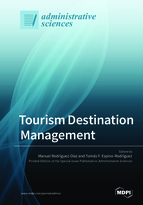Tourism Destination Management
A special issue of Administrative Sciences (ISSN 2076-3387).
Deadline for manuscript submissions: closed (30 June 2019) | Viewed by 20541
Special Issue Editors
Interests: destination management; destination marketing; distribution channels; logistic and supply chain management; online reputation; tourism marketing
Special Issues, Collections and Topics in MDPI journals
Special Issue Information
Dear Colleagues,
This Special Issue is aimed at studies focused on the management of tourist destinations. Destinations are complex and adaptive systems, where the different elements that make them up have to be oriented towards achieving a common objective that improves the competitiveness of the destination. Five main lines of research on tourist destinations can be established: 1) the management, planning and marketing of destinations, with special attention to the tourism supply chain, communication and integral management; 2) the sustainability of resources and capabilities; 3) the renewal of destinations in order to update their offer and main resources to maintain competitiveness; 4) online reputation and communication through social media in order to create and enhance a strong brand image and customer loyalty; and 5) the application of new technologies in order to develop smart destinations where the techniques for managing big data, machine learning and artificial intelligence in the individual or collective elements of destination are implemented.
Dr. Manuel Rodríguez-Díaz
Dr. Tomás F. Espino-Rodríguez
Guest Editors
Manuscript Submission Information
Manuscripts should be submitted online at www.mdpi.com by registering and logging in to this website. Once you are registered, click here to go to the submission form. Manuscripts can be submitted until the deadline. All papers will be peer-reviewed. Accepted papers will be published continuously in the journal (as soon as accepted) and will be listed together on the special issue website. Research articles, review articles as well as short communications are invited. For planned papers, a title and short abstract (about 100 words) can be sent to the Editorial Office for announcement on this website.
Submitted manuscripts should not have been published previously, nor be under consideration for publication elsewhere (except conference proceedings papers). All manuscripts are thoroughly refereed through a single-blind peer-review process. A guide for authors and other relevant information for submission of manuscripts is available on the Instructions for Authors page. Administrative Sciences is an international peer-reviewed open access quarterly journal published by MDPI.
Please visit the Instructions for Authors page before submitting a manuscript. Submitted papers should be well formatted and use good English. Authors may use MDPI's English editing service prior to publication or during author revisions.
Keywords
- Destination management
- Destination planning
- Destination marketing
- Destination competitiveness
- Destination positioning
- Destination sustainability
- Destination renovation
- Destination reputation
- Destination image
- Destination big data
- Smart destination
- Hotel offer
- Destination demand
- Complementary offer
- Destination security
- Tourism supply chain
- Social media destination
- Online communication destination
- E-WOM destination
- Destination relational capabilities
- Destination resources and capabilities
- Revenue Management and prices
- Positioning and integrated communication of tourist destinations
- Management and development of tourism in natural and rural areas
- Management and development of urban and cultural tourism
- Management and development of tourism in coastal destinations and coastal areas
- Quality management systems for tourist destinations
- Sustainable management of tourism destinations
- Implementation of tourism destination strategy: project management and monitoring
- Management and Organization of the tourist destination: DMO
- Human team management
- Governance of tourism destinations






